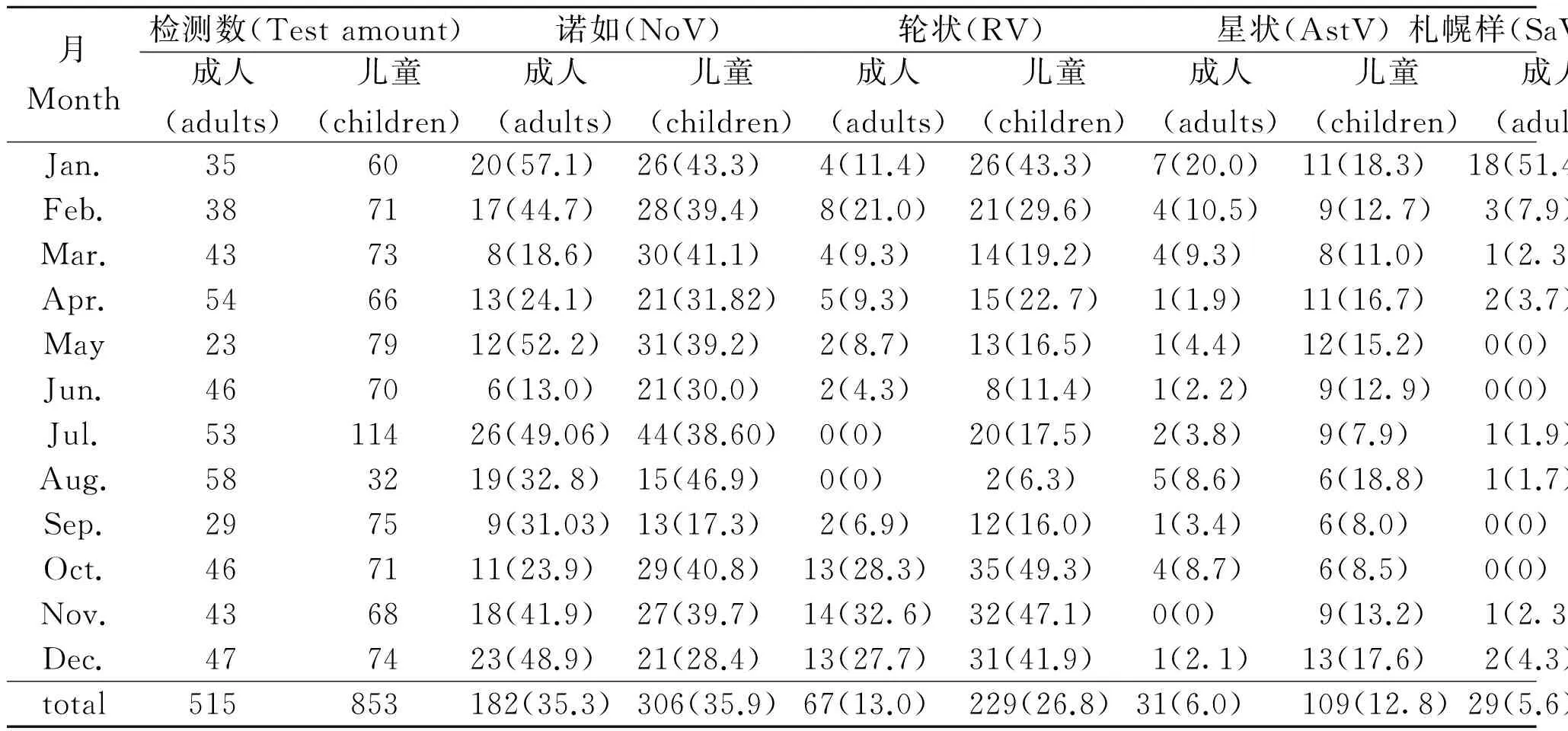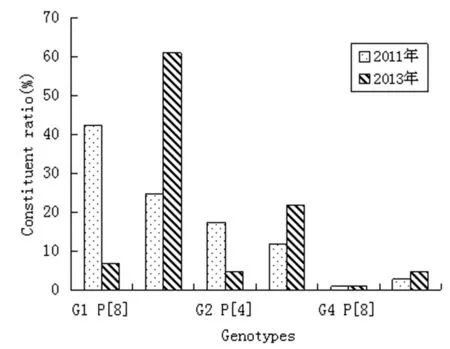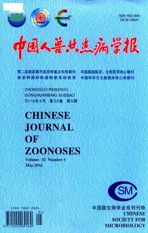2011年和2013年武汉市病毒性胃肠炎病原监测与分析
2016-07-28庞蓓蓓NobumichiKobayashi彭劲松王远虹
庞蓓蓓,周 璇,Nobumichi Kobayashi,彭劲松,王远虹
2011年和2013年武汉市病毒性胃肠炎病原监测与分析
庞蓓蓓1,周璇1,Nobumichi Kobayashi2,彭劲松1,王远虹1
1.武汉市疾病预防控制中心,武汉430015;2.日本札幌医科大学卫生系
摘要:目的监测和分析2011年和2013年武汉市婴幼儿和成人病毒性胃肠炎病原。方法用聚丙烯酰胺凝胶电泳及RT-PCR对胃肠炎患者腹泻大便样本进行轮状病毒、诺如病毒、星状病毒以及札幌样病毒检测,部分样本测序并比对同源性。用PCR检测腺病毒。结果轮状病毒、诺如病毒、星状病毒、札幌样病毒检出率分别为21.6%(296/1 368)、35.7%(488/1 368)、10.2%(140/1 368)和7.7%(105/1 368);肠道腺病毒在儿童患者中的检出率为8.2%(70/853)。诺如病毒和轮状病毒易感人群为13~24月龄和7~24月龄儿童,及40~59岁成人。轮状病毒检出高峰在秋冬季。星状病毒、札幌样病毒和腺病毒多发于2岁以下的婴幼儿,无明显季节分布。196人份A组轮状病毒基因型以G9P[8]为主(40.8%),其次为G1P[8](26.5%),G3P[8](16.3%)和G2P[4](11.7 %)。经测序比对诺如病毒基因型分别为GⅡ.4型(7/12),GⅡ.3型(5/12);星状病毒为1型(8/13),8型(4/13)和5型(1/13);札幌样病毒为GI.1型(2/6),GI 2型(2/6)和GⅡ.1型(2/6)。结论2011年和2013年武汉市婴幼儿和成人胃肠炎主要病原是诺如病毒,其次是轮状病毒。
关键词:胃肠炎病毒;监测;基因型;轮状病毒;诺如病毒
胃肠炎病毒是世界范围内引起婴幼儿以及成人急性胃肠炎的主要病原,其中轮状病毒(RV)是引起发展中国家婴幼儿死亡的主要病原之一;发达国家的死亡率虽然较低,但其较高的发病率仍然导致可观的经济损失。杯状病毒是病毒性胃肠炎的第二类常见致病因子,其次是星状病毒(AstV)和肠道腺病毒(EAdV)。人杯状病毒可分为2个属,诺如病毒(NoV)和札幌样病毒(SaV)。其中诺如病毒是引起非细菌性急性胃肠炎暴发最主要的病原。
为了解武汉市婴幼儿以及成人胃肠炎病毒的流行情况,本研究对武汉市2011年和2013年两个完整年度的病毒性胃肠炎病原进行了监测和分析。虽然全国其他地区对病毒性胃肠炎的研究较多,但监测人群主要是婴幼儿患者。本研究首次对武汉市儿童和成人开展了5种主要胃肠炎病毒的监测,首次分析了武汉市札幌样病毒和肠道腺病毒的流行情况,为预防控制病毒性胃肠炎提供了更全面的数据。
1材料与方法
1.1样本2011年1月-12月和2013年1月-12月从武汉市儿童医院,湖北省人民医院,武汉市第六医院和武汉市商业职工医院采集胃肠炎患者大便样本。
1.2方法
1.2.1试剂和仪器赛百盛RNA核酸提取试剂盒和树脂型TM基因组DNA提取试剂盒提取样本中的RNA和DNA用于检测NoV、AstV、SaV和EAdV。大连宝生物公司Takara One step PCR kit试剂盒用于逆转录-聚合酶链式反应(RT-PCR)扩增,PTC-100TM PCR仪进行PCR扩增反应。QIAGEN QIAxcel Advances毛细管电泳仪检测扩增样本并读取结果。
表1RT-PCR、PCR检测及测序引物
Tab.1Primers used for RT-PCR, PCR and sequencing in this study

病毒virus基因名称Targetgene基因组Genogroup引物Primer序列(5'-3')Sequence(5'-3')核苷酸定位Nucleotideposition检测方法Detectionmethod参考文献RefsNorovirusCapsidGIG1SKFCTGCCCGAATTYGTAAATGA5342cRT-PCR[4]CapsidGIG1SKRCCAACCCARCCATTRTACA5671cRT-PCR[4]CapsidGIIG2SKFCNTGGGAGGGCGATCGCAA5046RT-PCR[4]CapsidGIIG2SKRCCRCCNGCATRHCCRTTRTACAT5389RT-PCR&sequencing[4]CapsidGIIG2BTGGAGGGCGATCGCAATCT5048RT-PCR&sequencing[5]RoravirusGene9RVG9GGTCACATCATACAATTCT1062-1044RT-PCR[6]Gene9aAT8GTCACACCATTTGTAAATTCG178-198RT-PCR[6]Gene9aBT1CAAGTACTCAAATCAATGATGG314-335RT-PCR[6]Gene9aCT2CAATGATATTAACACATTTTCTGTG411-435RT-PCR[6]Gene9aDT4CGTTTCTGGTGAGGAGTTG480-498RT-PCR[6]Gene9aET3CGTTTGAAGAAGTTGCAACAG689-709RT-PCR[6]Gene9aFT9CTAGATGTAACTACAACTAC757-776RT-PCR[6]Gene9con3TGGCTTCGCCATTTLATAGACA11-32RT-PCR[7][8]Gene41T-1TCTACTTGGATAACGTGC339-356RT-PCR[7][8]Gene42T-1CTATTGTTAGAGGTTAGAGTC474-494RT-PCR[7][8]Gene43T-1TGTTGATTAGTTGGATTCAA259-278RT-PCR[7][8]Gene44T-1TGAGACATGCAATTGGAC385-402RT-PCR[7][8]Gene45T-1ATCATAGTTAGTAGTCGG575-594RT-PCR[7][8]AstrovirusProtease(ORF1a)GA.GBMON340CGTCATTATTTGTTGTCATACTRT-PCR&sequencing[9]Protease(ORF1a)GA.GBMON348ACATGTGCTGCTGTTACTATGRT-PCR&sequencing[9]SapovirusCapsidSav124FGAYCASGCTCTCGCYACCTAC5078-5098RT-PCR[10][11]CapsidSav1FTTGGCCCTCGCCACCTAC700-717RT-PCR[10][11]CapsidSav5FTTTGAACAAGCTGTGGCATGCTAC5112-5135RT-PCR[10][11]CapsidSav1245RCCCTCCATYTCAAACACTA5136-5181RT-PCR[10][11]AdenovirusFAdenoC(60)ATTTCACCTACTCTGGCTCCPCR[12]FAdenoD(56)CCTGAGTTATTATGCTGGAAPCR[12]
1.2.2核酸提取参照试剂说明书和文献进行[1]。
1.2.3RV筛查及G、P分型PAGE筛查RV[2]。半巢式RT-PCR进行G(VP7基因)、P(VP4基因)分型[3]。通过PCR不能确定基因型的样本经测序确定。用于RV基因分型和测序的引物[4-6]见表1。
1.2.4NoV,AstV和SaV的RT-PCR及EAdV的PCR检测用于检测和测序的引物[7-12]见表1。
1.2.5基因测序和分析PCR扩增产物送上海生物工程技术服务有限公司测序。测序结果通过BLAST(http://blast.ncbi.nlm.nih.gov/Blast.)在线比对。诺如病毒基因型再通过在线基因分型软件(http://www.rivm.nl/mpf/norovirus/typingtool)[13]确认。
2结果
2.1流行病学特征两年共检测1 368例样本,其中成人样本515例,儿童样本853例。NoV检出率为35.7%(488/1 368),RV为21.6%(296/1 368),AstV为10.2%(140/1 368),SaV为7.7%(105/1 368)。婴幼儿患者男女比例为1.6∶1,成人患者男女比为1∶1.2。儿童中EAdV检出率为8.2%(70/853)。
儿童样本中,NoV检出率为35.9%(306/853),在13~24月龄的婴幼儿中检出率最高(表2),除了9月份和12月份外其它10个月份的检出率均较高; 其次为RV,检出率为26.8%(229/853),RV检出年龄多集中在7月~24月龄,流行季节为秋冬季(10月~次年1月)。儿童样本AstV、SaV和EAdV的检出率分别为13.1%(109/853),8.9%(76/853)和8.2%(70/853),高发于2岁以下婴幼儿。AstV全年均有检出,10月~12月以及次年的1月相对较高。SaV 1月~2月检出率较高,6月、8月和9月未检出。腺病毒主要在2岁以下的婴幼儿中检出,70例阳性样本中有67例从该年龄段检出,全年均有病例分布,以4月,5月和8月发病为主。
成人样本中,NoV检出率为35.3%(182/515),RV为13.0%(67/515),AstV为6.0%(31/515),SaV为5.6%(29/515),以40~59岁为高发人群。AstV和SaV在成人中各年龄段均有检出。RV高发季节为秋冬季(10月~12月),NoV、AstV和SaV无明显季节性分布,其中SaV 5月、6月、9月、10月未检出。
2.2RV基因组和基因型共检出A组和C组轮状病毒分别为196例和3例。196例A组轮状病毒中2011年和2013年度检出的分别占109例和87例。对A组RV进行G,P分型。
表2武汉市胃肠炎病毒感染年龄分布
Tab.2The age distribution of gastroenteritis viruses in Wuhan

年龄组检测数诺如病毒轮状病毒星状病毒札幌样病毒AgegroupsTestamountNoVRVAstVSaV≤6m23885(35.7)37(15.6)35(14.71)15(6.3)7m-12m440150(34.1)147(33.4)48(10.9)36(8.2)13m-24m8841(46.6)29(33.0)18(20.5)17(19.3)25m-5y5016(32.0) 8(16.0) 3(6.0) 6(12.0)6y-14y3714(37.8) 8(21.6) 5(13.5) 2(5.4)15y-19y237(30.4) 3(13.0) 3(13.0) 2(8.7)20y-29y10131(30.7)10(9.9) 3(3.0) 6(5.9)30y-39y6323(36.5) 7(11.1) 3(4.8) 3(4.8)40y-49y9136(39.6)12(13.2) 6(6.6) 1(1.1)50y-59y10334(33.0)22(21.4) 7(6.8) 7(6.8)60y-69y7126(36.6) 6(8.5) 7(9.8) 5(7.0)≥70y6325(39.7) 7(11.1) 2(3.2) 5(7.9)Total1368488(35.7)296(21.6)140(10.2)105(7.7)
注:括号内的数据为阳性率(%)
Note:Inside the parentheses is rate of positive cases
表32011年和2013年武汉市成人与儿童RNA胃肠炎病毒感染季节分布
Tab.3Seasonality of RNA gastroenteritis viruses in adults and children in 2011 and 2013 respecitively in Wuhan

月Month检测数(Testamount)诺如(NoV)轮状(RV)星状(AstV)札幌样(SaV)成人(adults)儿童(children)成人(adults)儿童(children)成人(adults)儿童(children)成人(adults)儿童(children)成人(adults)儿童(children)Jan.356020(57.1)26(43.3)4(11.4)26(43.3)7(20.0)11(18.3)18(51.4)29(48.3)Feb.387117(44.7)28(39.4)8(21.0)21(29.6)4(10.5)9(12.7)3(7.9)22(31.0)Mar.43738(18.6)30(41.1)4(9.3)14(19.2)4(9.3)8(11.0)1(2.3)3(4.1)Apr.546613(24.1)21(31.82)5(9.3)15(22.7)1(1.9)11(16.7)2(3.7)4(6.1)May237912(52.2)31(39.2)2(8.7)13(16.5)1(4.4)12(15.2)0(0)2(2.5)Jun.46706(13.0)21(30.0)2(4.3)8(11.4)1(2.2)9(12.9)0(0)0(0)Jul.5311426(49.06)44(38.60)0(0)20(17.5)2(3.8)9(7.9)1(1.9)2(1.8)Aug.583219(32.8)15(46.9)0(0)2(6.3)5(8.6)6(18.8)1(1.7)0(0)Sep.29759(31.03)13(17.3)2(6.9)12(16.0)1(3.4)6(8.0)0(0)0(0)Oct.467111(23.9)29(40.8)13(28.3)35(49.3)4(8.7)6(8.5)0(0)2(2.8)Nov.436818(41.9)27(39.7)14(32.6)32(47.1)0(0)9(13.2)1(2.3)2(2.9)Dec.477423(48.9)21(28.4)13(27.7)31(41.9)1(2.1)13(17.6)2(4.3)10(13.5)total515853182(35.3)306(35.9)67(13.0)229(26.8)31(6.0)109(12.8)29(5.6)76(8.8)
注:括号内的数据为阳性率(%)
Note:Inside the parentheses is rate of positive cases

图1 2011年和2013年武汉市A组轮状病毒G,P基因分型Fig.1 Genotypes of group A rotavirus in 2011 and 2013 in Wuhan
2.3NoV,AstV、SaV测序结果NoV主要的基因型别为GII.4为(7/12),其次GII3(5/12)。GII.4型与韩国日本的流行株同源性为99%,GII.3型与贵州省流行株同源性为98%~99%。AstV主要基因型别为1型(8/13),与北京地区流行株同源性为96%~99%,其次为8型(4/13)和5型(1/13)。6例SaV样本中GI.1,GI.2和GII.1型均为2例。SaV GII 1与越南流行株同源性为100%。
3讨论
NoV为武汉市病毒性胃肠炎散发的主要致病病原,NoV检出率以及优势流行株与厦门[14]相似。诺如病毒检出率高于轮状病毒的流行趋势与巴西相似[15],较武汉市之前有所升高[8],提示流行风险加大并有暴发的可能。而2014-2015年武汉市的几起诺如病毒聚集流行也印证这种趋势。与武汉市2007-2010的监测数据相比,GII.3型检出率有所上升[8]。NoV的流行在武汉市呈现上升趋势,应引起足够重视,强对GⅡ.4型和GII.3型NoV的监测和防控,开展有针对性的预防措施,加强相关的卫生宣传,以防止其暴发大规模疫情。
2011年RV主要基因型为G1P[8]型2013年为G9P[8],与宁夏[16]和武汉地区之前的流行趋势[6]不同。这两年武汉地区G3P[8]的检出率仅为11.9%和21.8%,较以前出现了明显下降[6],与浙江和福建的报道一致[17-18],说明武汉市RV流行主要基因型出现了转换,需要密切关注流行趋势的变化。RV发病较集中在冬季10月-12月,故应根据流行特点实施相应的预防措施,更有效的减少其危害。目前本地区轮状病毒的优势基因型较以往也有所变化,理论上有必要相应调整疫苗成分,优化防控效果。
AstV和SaV阳性率较低,AstV基因型1型与北京地区流行株同源性较高,这与本地以往研究相同[19]。由于样本量及检出率较低,SaV分布规律不明显,主要型别与越南流行株同源性较高。
儿童中EAdV总检出率较低,全年各个月份都有分布,但相对集中于4-9月,与宁夏流行趋势类似[16]。发病年龄集中在2岁以内,因此应该加强2岁以内婴幼儿的预防并重视由其引起的腹泻的治疗。国内的相关研究报导较少,因此国内的相关流行病学研究仍需加强,以便更好地掌握其流行趋势,为防控腺病毒所致的胃肠炎提供决策依据。
虽然目前AstV、SaV和EAdV的检出率相对较低,其暴发的危害性不如RV和NoV,但是更加深入了解这两类病毒的流行及变异趋势,才能为有效控制和应对可能的流行做好准备。
目前胃肠炎病毒主要的感染人群仍然是2岁以下的婴幼儿,并多发于冬季。应针对性加强高发月份幼儿园、游乐场等幼儿集中场所的消毒和监督管理工作,并对高危人群在适当的季节结合其流行病学特点进行针对性强的免疫。
参考文献:
[1] Kobayashi N, Lintag IC, Urasawa T, et a1. Unusual human rotavirus strains having subgroup I specificity and “long” RNA electropherotype [J]. Arch Virol, 1989, 109(1-2):11-23.
[2] Yang T, Wang YH, Zeng J, et al. Comparision of different protocols on nucleic acid extraction and amplification of norovirus[J]. J Pub Heal Prev Med, 2009, 20 (1):87-89.
杨婷,王远虹,曾晶,等. 不同的核酸提取和扩增方案检测诺如病毒的方法与结果分析[J].公共卫生与预防医学, 2009, 20 (1):87-89.
[3] Fang ZY, Jin SJ, Qin SM, et al. [J].Serotypes of Group A Rotavirus Isolates Determined by PCR in Hebei and Henan Provinces, China [J]. Chin J Virol, 1994, 10(4):316-321.
方肇寅,晋圣瑾,秦树民,等. PCR方法用于我国A组轮状病毒的分型研究[J]. 病毒学报, 1994, 10(4):316-320.
[4] Gouvea V, Glass RI, Woods P, et al. Polymerase chain reaction amplification and typing of rotavirus nucleic acid from stool specimens [J]. J Clin Microbiol, 1990, 28(2):276-282.
[5] J R.Gentsch, R I Glass, P Woods, et al. Identification of group A rotavirus gene 4 types by polymerase chanin reaction[J]. J Clin Microbiol, 1992, 30(6): 1365-1373.
[6] Wang YH, Zhou X, Ghosh S, et al. Prevalence of human rotavirus genotypes in Wuhan, china, during 2008-2011:changing trend of predominant genotypes and emergence of strains with the P[8]b subtype of the VP4 gene[J]. Arch Viral, 2011, 156(12):2221-2231. DOI: 10.1007/s00705-011-1122-9
[7] Shigeyuki Kojimaa, Tsutomu Kageyamaa, Shuetsu Fukushia, et al. Genogroup-speccific PCR primers for detection of norwalk-like viruses[J]. J Virol Methods, 2002, 100(1-2):107-114. DOI: 10.1016/S0166-0934(01)00404-9
[8] Wang YH, Zhou DJ, Zhou X, et al. Molecular epidemiology of norovirus in children and adults with acute gastroenteritis in Wuhan, China, 2007-2010[J]. Arch Virol, 2012, 157(12):2417-2424. DOI: 10.1007/s00705-012-1437-1
[9] Belliot, GH laveran, SS Monroe. Detection and genentic differentiation of human astrovirus: phylogenetic grouping vaires by coding region [J]. Arch Virol, 1997, 142(7):1323-1334.
[10] Harada S, Okada M, Yahiro S, et al. Surveillance of Pathogens in outpatients with gastroenteritis and characterization of sapovirus strains between 2002 and 2007 in kumamoto prefecture Japan[J]. J Med Virol, 2009, 81(6):1117-1127.
[11] Oka T, Katayama K, Hansman G S, et al. Detection of human sapovirus by real-time reverse transcription-polymerase chain reaction [J]. J Med Virol, 2006, 78(10): 1347-1353.
[12] O'Neill HJ, McCaughey C, Coyle PV, et al. Clinical utility of nested multiplex RT-PCR for group F adenovirus, rotavirus and norwalk-like viruses in acute viral gastroenteritis in children and adults[J]. J Clin Virol, 2002, 25(3):335-343.
[13] Kroneman A, Vennema H, Deforche K, et al. Koopmans M(2011) An automanted genotyping tool for wnteroviruses and noroviruses[J]. J Clin Virol , 2011,51(2):121-125. DOI: http://dx.doi.org/10.1016/j.jcv.2011.03.006
[14] Zheng HN, Li L, Chen JJ. et al. The Study on Norovirus infection status among patients with virus diarrhea in Xiamen district [J]. Chin J Zoonoses, 2010, 26(3):259-262.
郑惠能,李莉,陈娟娟,等. 厦门地区病毒性腹泻诺如病毒感染状况[J]. 中国人兽共患病学报,2010, 26(3): 259-262.[15] Monica Simoes Rocha Ferreira, Mfria da Penha Trindade Pinheiro Xavier, Anna Carolina De Castro Tinga, et al. Assessment of Gastroenteric Viruses Frequency in a Children's Day Care Center in Rio De Janeiro, Brazil : A Fifteen Year Study(1994-2008) [J]. PloS ONE. 2012, 7(3):e33754. DOI: 10.1371/journal.pone.0033754
[16] Zhan J, Ma J, Chen H, et al. Etiological study on cases with viral diarrhea in Ningxia during 2011[J]. Chin J Epidemiol, 2014, 35 (6): 729-732.
詹军,马江涛,陈慧,等. 宁夏地区2011年病毒性腹泻病毒病原性研究[J]. 中华流行病学杂志, 2014, 35(6): 729-730.
[17] Yang AP, Wang M, Xu WL, et al. Molecular genotyping analysis of group A rotavirus in children[J]. Chin J Microecol. 2012. 24(1): 73-75.
杨爱平,汪敏,许文龙,等. 婴幼儿腹泻A群轮状病毒G和P的基因分型研究[J]. 中国微生态学杂志, 2012, 24(1):73-75.
[18] He AH, He JX, Yuan P, et al. Serotyping and genotyping of G and P types of rotavirus from infantile diarrhea in Fujian Province[J]. Chin J Zoonoses, 2002, 18(1):97-99.
何爱华,何家鑫,袁平,赵莉莱等,福建省婴幼儿腹泻轮状病毒G型和P型的分型研究[J]. 中国人畜共患病学报, 2002, 18(1): 97-99.
[19] Liu MQ, Yang BF, Peng JS, et al. Molecular epidemiology of astrovirus infection in infants in Wuhan, China[J]. J Clin Microbiol. 2007, 45 (4): 1308-1309.
DOI:10.3969/j.issn.1002-2694.2016.05.008
通讯作者:王远虹,Email:wyhhyc@163.com
中图分类号:R373.2
文献标识码:A
文章编号:1002-2694(2016)05-457-05
收稿日期:2015-08-01修回日期:2016-03-17
Surveillance and analysis of the pathogens of viral gastroenteritis in 2011 and 2013,Wuhan,China
PANG Bei-bei1, ZHOU Xuan1, Nobumichi Kobayashi2, PENG Jin-song1, WANG Yuan-hong*
(1WuhanCentersforDiseasePreventionandControl,Hubei430015,China;2DepartmentofHygiene,SapporoMedicalUniversitySchoolofMedicine,Sapporo,Japan)
Abstract:To survey and analyze the pathogens of viral gastroenteritis among infants and adults in 2011 and 2013 in Wuhan, the stool samples were detected for the rotavirus, norovirus, astrovirus and sapovirus by polyacrylamide gel electrophoresis (PAGE), RT-PCR and PCR. The nucleotide sequences of partial positive samples were determined and their identities were analyzed by BLAST and/or genotyping tool online. The detection rates of rotavirus, norovirus, astrovirus, sapovirus were 21.6%(296/1 368), 35.7%(488/1 368),10.2%(140/1 368) and 7.7% (105/1 368),respectively. The detection rate of adenovirus in children was 8.2% (70/853).The detection rates of norovirus and rotavirus were higher in 13-24 months and 7-24 months age groups, respectively, and 40-59 years old age group. The detection rate of rotavirus was higher in autumn and winter. Astrovirus, sapovirus and adenovirus were more frequently detected in children under 2 years old. Seasonality was not observed in astrovirus, sapovirus or adenovirus. The genotypes of 196 group A rotavirus were determined. Of these, the most frequent were G9P[8](40.82%), followeing by G1P[8](26.53%), G3P[8](16.33%)and G2P[4](11.73%). The genotypes of norovirus were GII 4(7/12) and GII 3(5/12), and that of astrovirus were type 1(8/13),type 8(4/13) and type 5(1/13). The genotypes of sapovirus were GI.1(2/6), GI.2 (2/6) and GII.1 (2/6). The main pathogens of viral gastroenteritis were norovirus and rotavirus in 2011 and 2013, in Wuhan.
Key words:gastroenteritis virus; surveillance; genotype; rotavirus; norovirus Supported by National Natural Science of Foundation of China (No.81071352), the Scientific Research Foundation of Health and Family Planning Commission of Wuhan (Nos. WG09C08, WG12C03)Corresponding author: Wang Yuan-hong, Email: wyhhyc@163.com
国家自然科学基金(No. 81071352)、武汉市卫计委科研课题(No.WG09C08)和(No. WG12C03)联合资助
